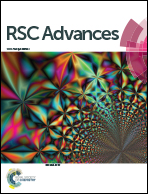High-performance nickel cobalt sulfide materials via low-cost preparation for advanced asymmetric supercapacitors†
Abstract
In this work, porous nickel cobalt sulfide electrode materials with different Ni–Co ratios were successfully synthesized through a simple and efficient coprecipitation method. Benefiting from the high electronic conductivity, loosely porous morphology and cooperative redox reactions of the as-prepared electrode materials, the nickel cobalt sulfide electrode materials with the Ni/Co ratio being 2 : 1 exhibit high specific capacitance (1259 F g−1 at 1 A g−1), excellent rate capability (945 F g−1 at 50 A g−1) and long cycling life (90.0% retention after 2000 cycles). Additionally, the asymmetric device, using the nickel cobalt sulfide electrode materials with the Ni/Co ratio being 2 : 1, fabricated in this work deliver a high energy density of 44.44 W h kg−1 at a power density of 954.14 W kg−1 and a high power density of 23.853 kW kg−1 at an energy density of 25.6 W h kg−1, and also show excellent cycling stability. Our results may pave the way for employing transition metal sulfides for advanced energy storage systems through a low-cost coprecipitation method.



 Please wait while we load your content...
Please wait while we load your content...